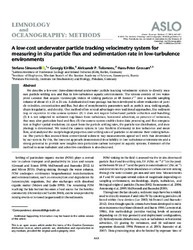A low-cost underwater particle tracking velocimetry system for measuring in situ particle flux and sedimentation rate in low-turbulence environments
DOI: https://doi.org/10.1002/lom3.10341
Persistent URL: http://resolver.sub.uni-goettingen.de/purl?gldocs-11858/8900
Persistent URL: http://resolver.sub.uni-goettingen.de/purl?gldocs-11858/8900
Simoncelli, Stefano; Kirillin, Georgiy; Tolomeev, Aleksandr P.; Grossart, Hans-Peter, 2019: A low-cost underwater particle tracking velocimetry system for measuring in situ particle flux and sedimentation rate in low-turbulence environments. In: Limnology and Oceanography: Methods, Band 17, 12: 665 - 681, DOI: 10.1002/lom3.10341.
 |
Dokument öffnen: |
We describe a low-cost three-dimensional underwater particle tracking velocimetry system to directly measure particle settling rate and flux in low-turbulence aquatic environments. The system consists of two waterproof cameras that acquire stereoscopic videos of sinking particles at 48 frames s−1 over a tunable sampling volume of about 45 × 25 × 24 cm. A dedicated software package has been developed to allow evaluation of particle velocities, concentration and flux, but also of morphometric parameters such as particle area, sinking angle, shape irregularity, and density. Our method offers several advantages over traditional approaches, like sediment trap or expensive in situ camera systems: (1) it does not require beforehand particle collection and handling; (2) it is not subjected to sediment trap biases from turbulence, horizontal advection, or presence of swimmers, that may alter particulate load and flux; (3) the camera system enables faster data processing and flux computation at higher spatial resolution; (4) apart from the particle settling rates, the particle size distribution, and morphology is determined. We tested the camera system in Lake Stechlin (Germany) in low turbulence and mean flow, and analyzed the morphological properties and settling rates of particles to determine their sinking behavior. The particle flux assessed from conventional sediment trap measurements agreed well with that determined by our system. By this, the low-cost approach demonstrated its reliability in low turbulence environments and a strong potential to provide new insights into particulate carbon transport in aquatic systems. Extension of the method to more turbulent and advective conditions is also discussed.
Statistik:
ZugriffsstatistikSammlung:
- Geographie, Hydrologie [454]
This is an open access article under the terms of the Creative Commons Attribution License, which permits use, distribution and reproduction in any medium, provided the original work is properly cited.

